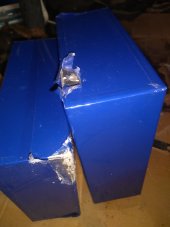New lishen 272Ah cells 20% charged in 16 cell series on double cardboard in basement..no connection to anything else.
Bad luck caused the dishwasher to release some gray water in the basement.
A little soaked up in the cardboard.
Did not think much about it. Two days later I noticed a bubble at the bottom of two cells.
In some of the aluminum cases it seems to be a thru hole. No liquid is coming out.
Yet..
Likely caustic dishwasher water and the galvanic potential of the aluminum casing after the liquid slowly migrated thru the blue plastic.
Johan
Bad luck caused the dishwasher to release some gray water in the basement.
A little soaked up in the cardboard.
Did not think much about it. Two days later I noticed a bubble at the bottom of two cells.
In some of the aluminum cases it seems to be a thru hole. No liquid is coming out.
Yet..
Likely caustic dishwasher water and the galvanic potential of the aluminum casing after the liquid slowly migrated thru the blue plastic.
Johan




